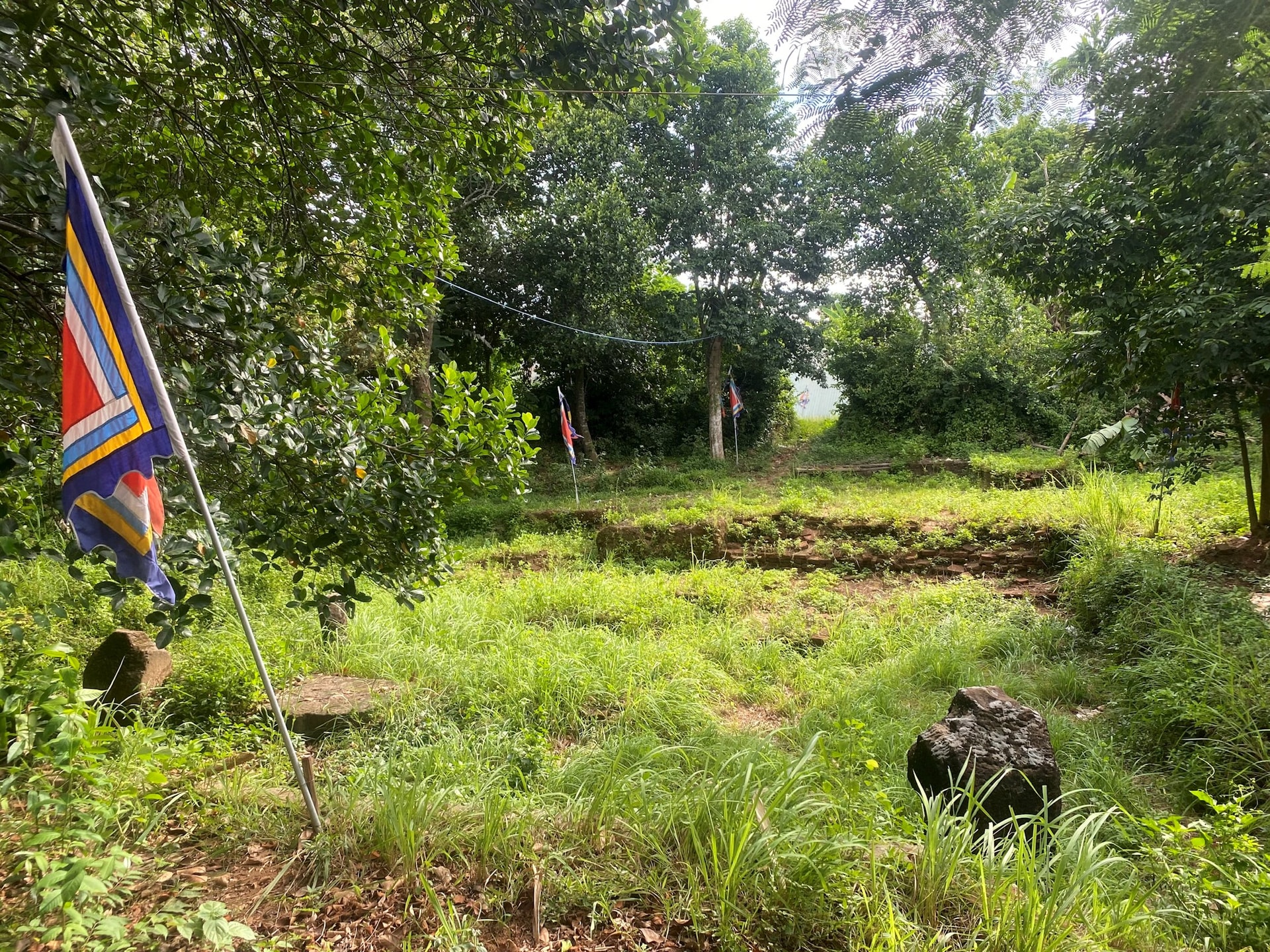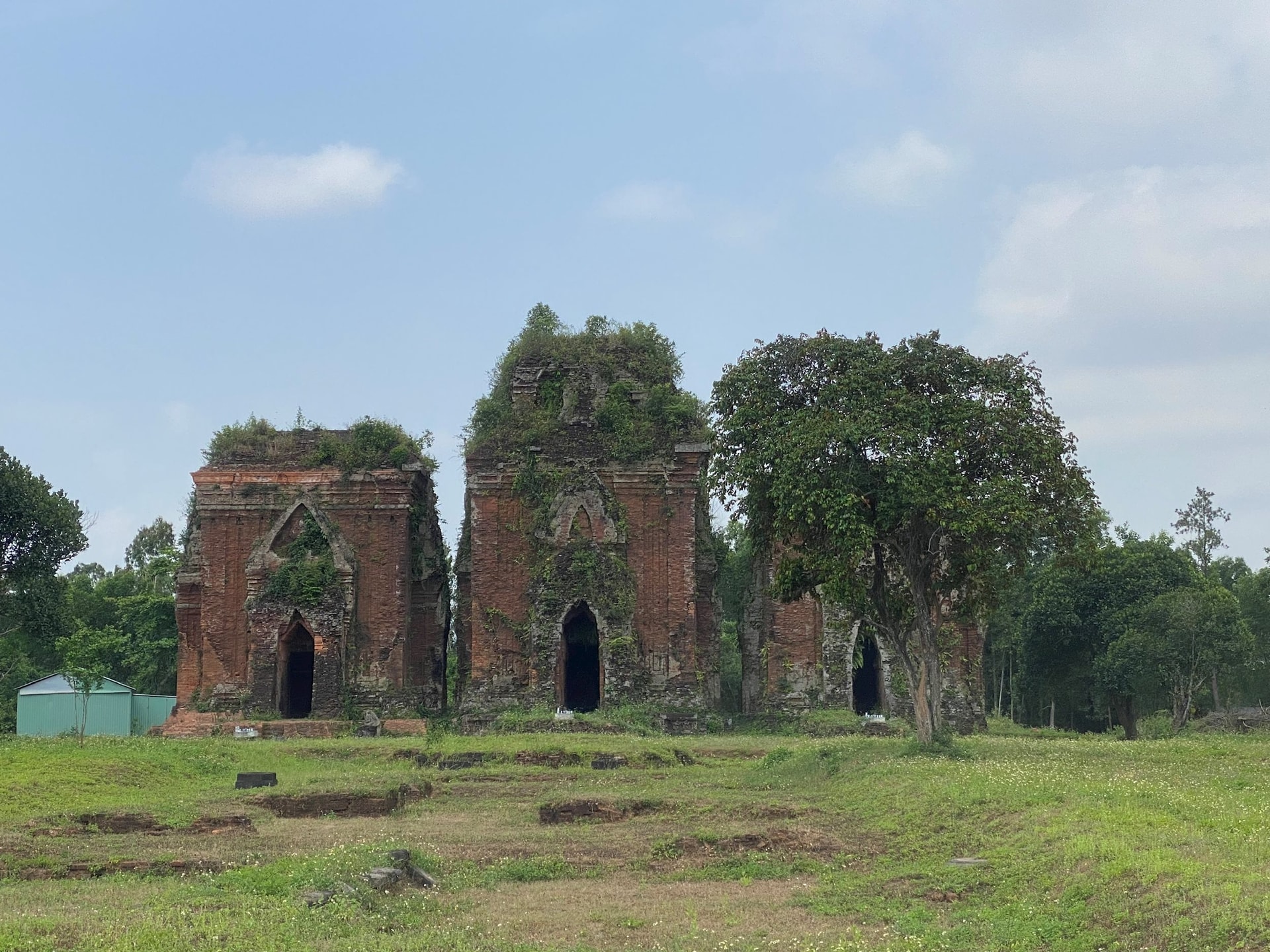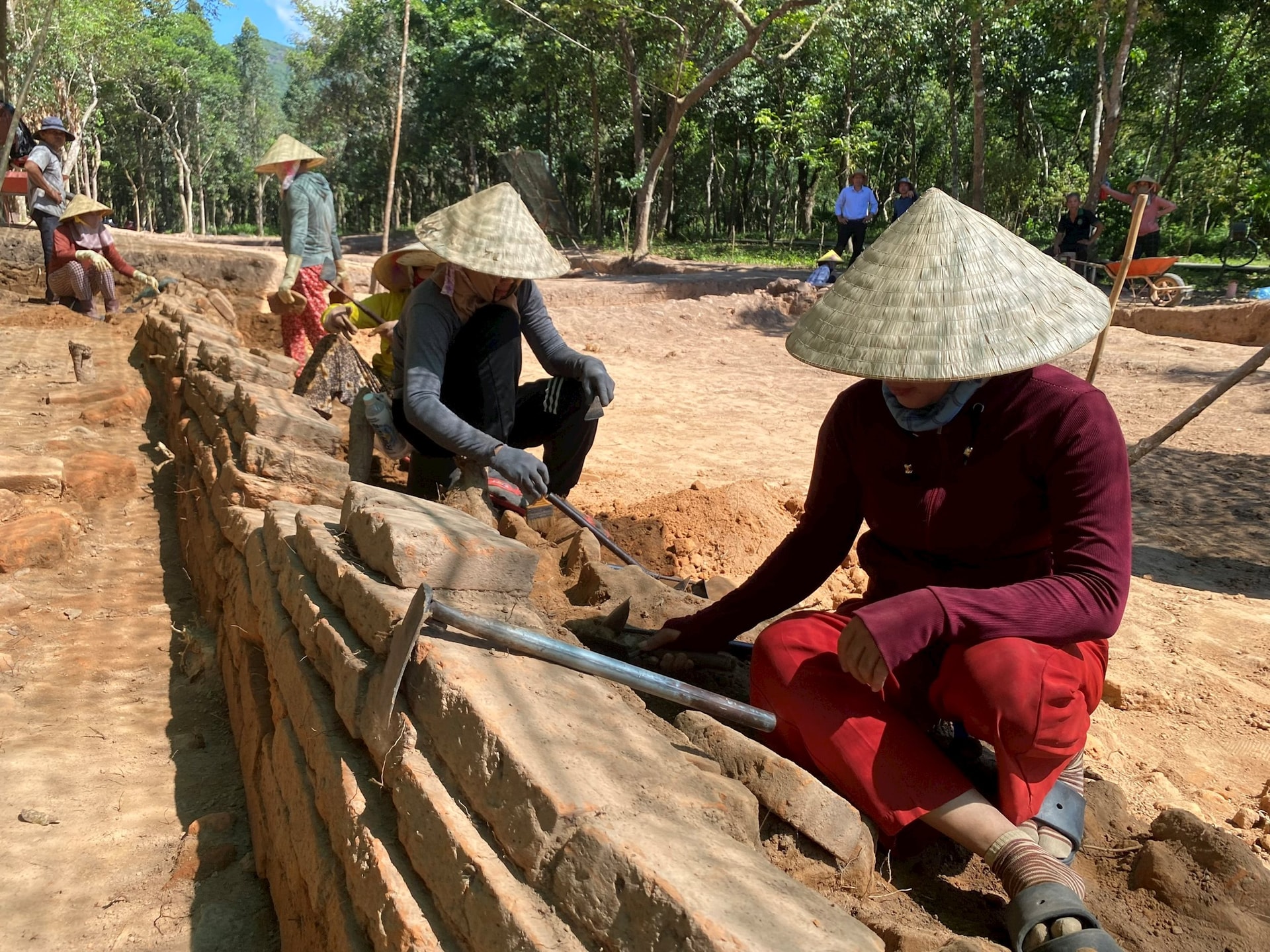
Reviewing and compiling a planning map of archaeological sites with detailed descriptions is considered necessary to help managers and scientists easily grasp the current situation, and at the same time propose solutions to preserve and effectively promote archaeological sites when conditions are favorable.
Lack of restoration solutions after excavation
In 2011, while digging the foundation for a house, people discovered traces of a Cham architectural work in Phong Le, Cam Le district (old). The Museum of Cham Sculpture conducted an emergency archaeological excavation, revealing the foundations of a tower complex here. At the end of 2020, the Phong Le Cham relic was recognized as a city-level archaeological relic. However, since then, the relic has been overgrown with wild grass and moss on brick and stone artifacts.
Previously, in 2003, My Son F1 tower (Thu Bon commune, Da Nang city) was excavated, revealing many beautiful patterns on the walls at the base of the tower, but due to lack of funds and professional factors, the project was not restored. Up to now, F1 tower has seriously degraded; the wall joints are broken; the bricks at the base of the tower are discolored and the soil is restored...
The Phong Le Cham relic and My Son F1 tower are just two typical examples of archaeological excavations not associated with restoration, causing damage to the relics. In addition, we can mention a number of other archaeological sites and relics, mainly Cham architecture and Sa Huynh culture, which are in a similar state or have been invaded by moss and mold, such as Duong Bi, Khuong My, and Chien Dan towers (mandapa, sculptures on the base of the wall, etc.).
According to MSc. Nguyen Van Manh - Vietnam Institute of Archaeology, the best way to preserve archaeological relics is to excavate combined with restoration and promote the value of the relics. However, the previous viewpoint was that excavation was mainly to retrieve documents and artifacts and then fill them back up, without focusing on promoting the value of the relics. Nowadays, socio -economic conditions have changed, resources are easier to find, so the trend of excavation combined with restoration and promoting the value has been focused on, including the application of technology, data, and 3D reconstruction of relics, helping to come up with excavation ideas and restoration models in the future.

“Archaeology and restoration must always go hand in hand. Archaeology helps discover and treat relics, while restoration is the preservation and conservation of relics. These two issues must be closely linked, even mandatory,” said Master Nguyen Van Manh.
Da Nang City is a locality with a dense and diverse cultural heritage from Sa Huynh, Champa to Dai Viet (mainly from the Nguyen Lords and Nguyen Dynasty). In some places, there is even an overlap between the ancient Vietnamese and Cham relics.
Associate Professor, Dr. Le Dinh Phung - an archaeologist who has spent many years researching and excavating Cham relics and ruins in Da Nang city, acknowledged that very few localities have all types of relics like Da Nang. However, because there are so many types of relics and different eras, in the past, the locality has only focused on solving the problem of Cham relics because of their outstanding and unique characteristics.
“As the center of the Champa civilization, Da Nang has become a land of convergence of many types of Cham architecture. If we connect all the remaining Cham relics in the area from Tra Kieu, My Son to Dong Duong, Bang An, Chien Dan, Khuong My and dozens of other ruins, we will see the continuity and diversity of this type of architecture that not every place has” - Associate Professor, Dr. Le Dinh Phung acknowledged.
Mapping the site
In fact, about 25 years ago, the Da Nang Museum also coordinated with the Faculty of History, University of Social Sciences and Humanities, Hanoi National University to conduct an archaeological survey in Quang Nam and Da Nang and discovered a number of sites with traces of Cham culture such as An Son and Cam Mit pagodas.

The Museum of Cham Sculpture has also implemented the project “survey, collection of artifacts and mapping of Cham relics in Da Nang city” (old). Based on the thematic reports of the project, in August 2014, the book “Cham relics in Da Nang city and new discoveries” was published.
The book is presented with many maps and detailed images of relics and artifacts to help readers easily compare. The editorial team also described 7 main relic sites, where there is clear evidence of Cham architecture that once existed, and valuable artifacts were found, including An Son, Cam Mit, Khue Trung, Ngu Hanh Son, Phong Le, Qua Giang and Xuan Duong.
Previously, in 1998, author Ho Xuan Tinh also published the work "Cham ruins in Quang Nam" (old) listing 25 ruins widely distributed throughout Quang Nam province (old) from Dien Ban, Duy Xuyen, Thang Binh to Tam Ky, Nui Thanh... such as Mieu Ba, Trien Tranh, Chua Vua, Go Loi, An Thai, Go Gach... thereby helping to shape a preliminary "map" of the system of Cham relics and ruins at the present time.
MSc. Nguyen Van Manh said that through exploration, fieldwork, and archaeological excavation activities, he has provided a clear view of the dense density of Cham relics in Da Nang. In particular, the system of relic axes stretching from Tra Kieu through Chiem Son to My Son has demonstrated the continuous development of the Champa dynasty for many centuries (4th-13th centuries), and at the same time brought many speculations about the cultural and political picture of the ancient Champa kingdom.
It can be affirmed that building a map of archaeological relics is very necessary now and for the future, especially relics related to Champa culture. Statistics show that the Thu Bon river axis alone has a dense presence of architectural works from Dai Chiem port to Tra Kieu capital, Chiem Son basilica, My Son temple complex...
Source: https://baodanang.vn/di-tim-tieng-noi-tu-nhung-phe-tich-3301444.html





![[Photo] Where the history of resistance comes alive with modern technology at "95 years of the Party Flag lighting the way"](https://vphoto.vietnam.vn/thumb/1200x675/vietnam/resource/IMAGE/2025/9/12/81c1276f52b849c8b16e2d01dd1c85e4)


![[Photo] Thac Ba Lake: Towards an international-class tourism, resort and cultural center by 2040](https://vphoto.vietnam.vn/thumb/1200x675/vietnam/resource/IMAGE/2025/9/12/0940443efe0a427b88707caadba1cc41)


































































































Comment (0)